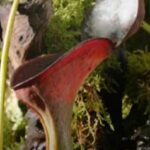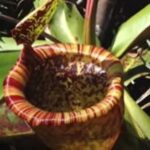As an Amazon Associate, this site earns commissions from qualifying purchases. For more details, click here.
When feeding your pitcher plant, what do you usually give it? For most people that would be insects, fish food or mealworms. But you have probably seen or heard stories of pitcher plants eating frogs. Is this true and should you allow your plant to consume them?
Pitcher plants often feed on small insects, but they do eat small frogs and lizards too. One frog pitcher plants do not eat is the Microhyla nepenthicola. It is one of the world’s smallest frogs and lives inside the plant where it lays its eggs.
Why Pitcher Plants Eat Frogs
Pitcher plants differ from regular plants in many ways, not just by being meat eaters. Carnivorous plants for instance, only grow in poor, acidic soil. Plants cannot live in nutrition-deprived material, but pitcher plants do. In fact that is the only soil they can thrive in. if you want to grow nepenthes, use only soil that is suitable for carnivorous plants such as the Jungle House Potting Mix.
While pitcher plants will live on this soil, they still need nutrition. The only available sources are bugs and insects which is why these plants developed traps. These mechanisms are aimed mostly at small crawling bugs, but if a frog gets caught, the plant will eat it as well.
Pitcher plants consume frogs and other insects for nitrogen, phosphorus and other nutrients. When a frog gets caught and eaten, it is converted into a solution containing elements that are not in the soil.
Nepenthes and other pitcher plants rely on photosynthesis to make glucose, which is plant food. This is enough for the plant to live on, but they need additional requirements to reach maximum potential. This is where the nutrients become important.
Frogs and insects are very different, but for pitcher plants they are the same thing: sources of nutrition. As long as the plant is able to dissolve and digest an animal, it gets turned into a solution consisting of amino acids and other elements. Pitcher plants extract nitrogen from this solution.
Pitcher plants depend on glucose for food, but eating bugs have nutritional benefits too. Carnivorous plants do not limit themselves to just bugs however, as frogs provide the same advantages. Nepenthes and sarracenia though, should never be given food for human consumption.
Carnivorous plants have different ways of trapping insects, but they do so for the same reason: nutrition. Pitcher plants rarely eat frogs because they are not as common in their natural habitat. A lot of them are also too large for the pitchers.
How Many Frogs Can Nepenthes Eat?
There is no single answer to this because it depends on several factors. The size of the pitcher, the size of the frog, what foods the plant eats and more.
Outdoor pitcher plants do not have to be fed because they attract prey. Indoor pitcher plants should eat at least once a month but no more than once a week.
In the case of frogs for instance. One small frog per week is enough for a nepenthes. However some pitcher plants can eat a few more insects especially if they are small.
Size matters as well. The pitcher of a nepenthes rajah is 16 inches tall and 7 inches wide, large enough to eat a rat or frog. The largest nepenthes however, is the Attenborough pitcher plant. Its pitchers are 11.8 inches wide and the plant itself is 4.9 feet tall.
Of course the average pitcher plant is way smaller than this. The typical nepenthes is small enough to hold in your hands and its trap is only a few inches wide.
Since nepenthes are tropical plants they are usually grown indoors and fed. You can give it frogs if you like but limit this to one per week at most. Do not give it anything too large. If you want to mix it up with other food we suggest TetraColor Plus Fish Flakes as it is great source of nutrition.
If you have a sarracenia growing outdoors, nutrition will not be a problem. All it needs are sunlight, water, soil, humidity and good airflow. A healthy environment is also a must for indoor pitcher plants.
Under these conditions the plant will live even with limited food intake. But being outdoors means access to frogs, flies, and all kinds of prey. No need to do any feeding as the plant will lure these insects with nectar.
Can Frogs Live inside Pitcher Plants?
While pitcher plants are carnivorous, it has symbiotic relationships with various animals including frogs. One of the smallest frog species in the world, the Microhyla nepenthicola, actually resides in the pitchers that trap and eat other prey.
Researchers in Borneo found these frogs – 04. to 0.5 inches long – dwelling inside nepenthes ampullaria, a pitcher plant native to the jungles of Borneo.
Whereas insects fall prey to the pitcher, these frogs lay their eggs along its walls and use the liquids inside the plant to nurture tadpoles. This is an example of an animal that benefits from the pitcher plant, though it is unknown if the plant also benefits from this. Presumably the leftovers are consumed by the plant.
There are other animals that have symbiotic relationships with pitcher plants. Tree shrews, crab spiders and ants are just some of them. Each one is unique but basically, these creatures hide inside the pitcher and eat any prey caught. The leftovers are digested by the plant. In return these animals help the plant catch more prey.
These are mutually beneficial relationships, similar to plants and bees. Bees collect nectar to use as honey, all the while pollinating the plant. This is why pitcher plants try to avoid eating pollinators though on certain situations this can happen.
It is possible for very small frogs to hide in the pitcher to lay its eggs. But so far only the Microhyla nepenthicola has been found to do so. Other frog species that jump into pitchers are eaten.
Why are Frogs Attracted to Nepenthes?
Frogs are drawn not just to nepenthes but also sarracenia. Sometimes you will also see one caught up inside a Venus flytrap too. While frogs are not insects, they are drawn to pitcher plants for the same reasons.
Pitcher plants secrete nectar around its pitchers. This nectar is similar but not the same as the substance that pollinators take. The nectar produced for prey are also close to the traps, whereas nectar for pollinators are on the flowers.
It is this nectar that draws gnats, aphids, ladybugs, beetles and all kinds of insects to pitcher plants. And sometime even frogs, lizards and mice fall for it too.
If a frog is drawn to the scent, any number of things can happen depending on its size. A large frog will not even fit into the trap for example. Smaller frogs as discussed earlier, end up nestling inside the pitcher and lay their eggs.
Other frogs end up as food for the plant though. They jump onto the pitcher but they slip into the trap. Aside from its sweet scent, nectar moistens the pitchers, making it difficult for a prey to keep its balance.
After the frog falls into the cavity, the liquids inside will suffocate it. Even if the frog survives this, the digestive enzymes will eventually break it down.
The dissolved remains are consumed by the plant and converted into nutrients. The process is the same for any other animal that is caught and digested by a pitcher plant.
This is only possible if the frog is small enough to fall into the trap. The plant must also be healthy enough to digest the animal. An empty pitcher cannot eat any food.
Nepenthes may take days to finish digesting an animal, especially a large one. But this also depends on the health and size of the plant.
Conclusion
So yes, pitcher plants will eat frogs if they fall into the trap. Unless you have a nepenthes rajah however, there is no need to worry about a large frog or rat getting caught and rotting. And if a frog does get eaten, it will benefit your plant.

My fascination with carnivorous plants began many, many years ago with Venus Fly Traps. Now I am more than happy to impart what I know with other enthusiasts and those who are curious about meat eating plants.



